In the Wake of Moshulu
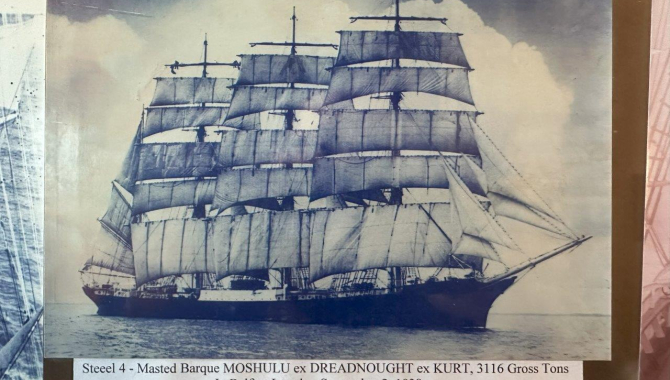
Just as modern Italians saunter along the Appian Way, in the footsteps of Caesar’s legions, so too do we on Europa steer a richly storied course. We are motoring North now, in search of the Westerlies above the Azorean high-pressure zone, where we will shape our course for the Channel and then for Amsterdam.
Though we have the luxury of hunting the wind, we are, like the mariners of old, ultimately at the mercy of Aeolus’ whims. During a prior voyage with Europa, my pal, Nick Turner, recommended I read Eric Newby’s “The Last Grain Race”, which covers the voyage of the barque Moshulu, and her epic passage from South Australia, ‘round the Horn, bound for the Cove of Cork. Today, as Europa quests for her breeze, I am reminded of the countless sailors who have traversed these same waters, waiting for the wind to veer to the West-South-West. I write this between tricks at the helm and periods of standing lookout; with nothing but the dome of the sky as far the horizon, I daydream of Moshulu in these very waters. Though we are separated by some ninety years, we are, perhaps, not so different.
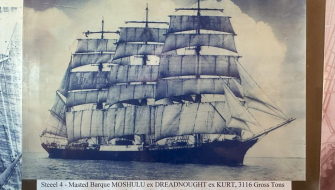
Europa is one of a very few square-rigged vessels that still wanders the planet’s oceans. Though the heyday of tall ships was well past by the time Eric Newby sailed with Moshulu in 1938-39, it was not like today where the mere sight of a square-rigger causes general wonder. To be sure, if one compared Moshulu of 1939 with Europa of 2025, one could spot the differences. For starters, we on Europa are hardly subjected to the ammoniac stockfish and sugar rations of Newby’s voyage. Far from it: on a daily basis, Europa’s cook, Gjalt, and his assistant, Cato, produce as delightful a smorgasbord as one could hope for at any terrestrial establishment.
Similarly, though Europa has a modern suite of navigation and meteorologic technology, Moshulu was as cut off from the outside world as Cook was on Endeavour, barring the rumours of Moshulu’s mate having a secret wireless set in his cabin. Oddly enough, Europa scans as older than Moshulu in some aspects, as she relies on raw manpower to brace and haul her yards, whereas Moshulu’s massive spars required deck winches to perform those same actions. Furthermore, Europa maintains a set of studdingsails (pronounced “stuns’ls”) on her foremast, whereas the narrow profit margins of grain hauling in Newby’s day did not allow for the precarious beauty of such features. Nonetheless, much of our day-to-day existence on Europa would have been intimately familiar to Newby and the crew of Moshulu.
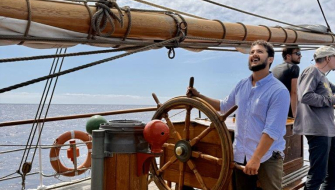
Europa, like Moshulu, is barque-rigged, albeit with three masts instead of four. The deckhands of Moshulu would have felt right at home with the constant hum of maintenance and general upkeep that provides the backdrop to our life on board. On Europa’s prior passage, from Brazil to the Azores, much of her metal work was chipped and repainted, and now, on our way to Amsterdam, every inch of woodwork is being sanded and painstakingly varnished. If polished brass can gleam, then freshly varnished wood shines no less brilliantly; a subtle, yet rich contrast against the ocean blue. Though our modern materials might last longer, the work itself is much the same. On some level, even Europa’s method of sail training resembles that of the merchant windjammers, with a focus on learning by doing, greenhorns mixed in with experienced hands, rather than by formal set-piece instruction, as seen on some modern tall-ships. We wear harnesses to climb and are not driven onto the yards by blows and harsh words, but we do learn the pin-rail by setting sails rather than by reading diagrams. Finally, we are truly a sailing vessel, not a motorboat that sets sails for pretty pictures and festivals. Perhaps Newby’s ghost was looking down on us from Fiddler’s Green, grinning as he watched us set and take down the entire suite of sails twice as Janke, Dan, and Evelien (Europa’s skipper and mates) stretched every sinew to harness the fleeting winds. In the high southern latitudes, half a world away, I have seen Europa, decks awash, beat into a gruelling Antarctic headwind: like Moshulu, we truly sail.
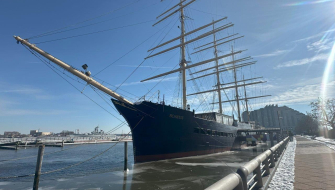
High on the mainmast above me, the hands are putting the finishing touches on the main-skysail yard, roving the sheets through blocks so much smaller than their topgallant and topsail cousins. Just in the time I have been writing, we have found our westerlies, and with studdingsails set aloft and alow, on both sides, we are now bound for the Channel. Eric Newby’s homeward bound voyage in 1939, in these same waters, was characterized by the fatigue of months at sea, by a longing for home, and by the rumour of war. Conversely, most of us are fresh from the Azores, excited for brisk sailing, and looking forward to a glorious conclusion to our journey, sailing in parade through the heart of Amsterdam. Writing here, in Europa’s deckhouse, surrounded by images of famous tall ships, like the Flying Cloud and Sir Lancelot, I cannot but revel in the rich history of these waters and our course. Perhaps the deckhands on Moshulu whistled the old shanty, Spanish Ladies, that is on the lips of many here on board:
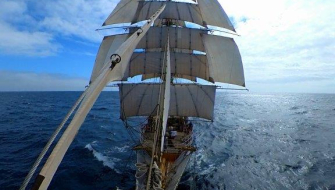
We hove our ship to, with a wind from sou-west, boys,
We hove our ship to, for to strike soundings clear,
’Tis forty-five fathoms, with a white sandy bottom,
We squared our main yard and up-Channel did steer.
